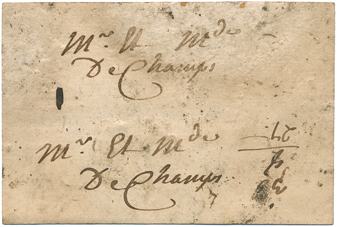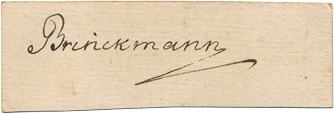****************
# 28
The
story of finding a card with a story
It
is April, 1998 and my wife and I are in Paris, at the famous Marché aux puces
de Saint-Ouen. An enormous market covering many streets and buildings that sells
antiques, collectibles and inexpensive clothing. Just try to find a secondary
used playing card here sometime. I follow my instincts. They have to be lying
around here somewhere. But, no, the only card I find is not lying around but
hanging up. It’s in a plastic file sheet on the wall behind a large desk on
which a surly Frenchwoman is working on a crossword puzzle. I stare from a
distance at a jack of spades.
|

|
From
here, it looks 18th century. In my best French, I ask if I
can see the card. “You’re looking at it right now,” says the lady
without looking up from her puzzle. My wife wants to leave the shop
right away, but I persist. This is the reason I’ve come to Paris. With
a sigh, the lady stands up and takes the plastic file sheet from the
wall. Before handing it to me, she tries to discourage me again. “The
other side isn’t as nice,” she warns me. My heart immediately skips
a beat. I turn the file sheet over. The back of the card has been
written upon. I summon all my acting talents and moan, “Ah” (Oh,
dear!), ”Mais non!” (It can’t be true!) and “Mon Dieu!” (My
God!). I then haggle the price at length because the card has been
written upon and has an ink spot. The lady takes the bait. “No,” I
say, “you don’t have to wrap it.” Outside, I tell my wife. It’s
a good thing the Frenchwoman doesn’t understand Dutch. |
Back
in our Paris hotel. My wife is already asleep but I want to take another look at
my acquisition. The only place where I can make light is the bathroom. There,
sitting on lid of the toilet, I admire the woodcut of the jack of spades colored
in with stencils. On the right, a little dog is jumping up onto his leg. Between
the jack’s legs, the maker has printed his name: Fournel Desvignes. Never
heard of him. I’ll have to look him up when we get home. The surface on the
right side of the card is damaged as if it had been stuck between a cupboard and
a wall. Or left on a stone floor with something heavy on top of it. I love
things that show traces of their ‘life’ - how they’ve ‘suffered and
survived’, dirty, damaged and worn. Therefore I do not clean or restore my
playing cards. I keep them as they are.
| The
back of this French card isn’t so pretty either. I didn’t exaggerate
this afternoon. Written twice in ink are the same names: Mr. and Mrs.
DeChamps. They were written quickly and smoothly like you would sign
your name. A sum is written as well: 38 with 8 underneath, a line and
then 27. Or is it 35? That would make more sense. Why would anyone write
a name twice on the back of a playing card? |

|
 |
I
already have a couple of visiting cards made from playing cards in my
collection. Although never proven, everything points to the fact that
the visiting card originated sometime in the 18th century
when people started writing their names on the blank sides of playing
cards. |
|
The
traditional size of a conventional printed visiting card is practically
the same as that of a French playing card made during that time. To
economize on paperboard visiting cards have also been made on playing
cards cut in half. |

|
Everything
suddenly clicks into place: the card in which someone had written the names of
Mr. and Mrs. DeChamps twice was intended to be used as two visiting cards.
Either the ink spot or the sum of numbers had prevented this, but the card was
never cut and used.
Gejus
****************



